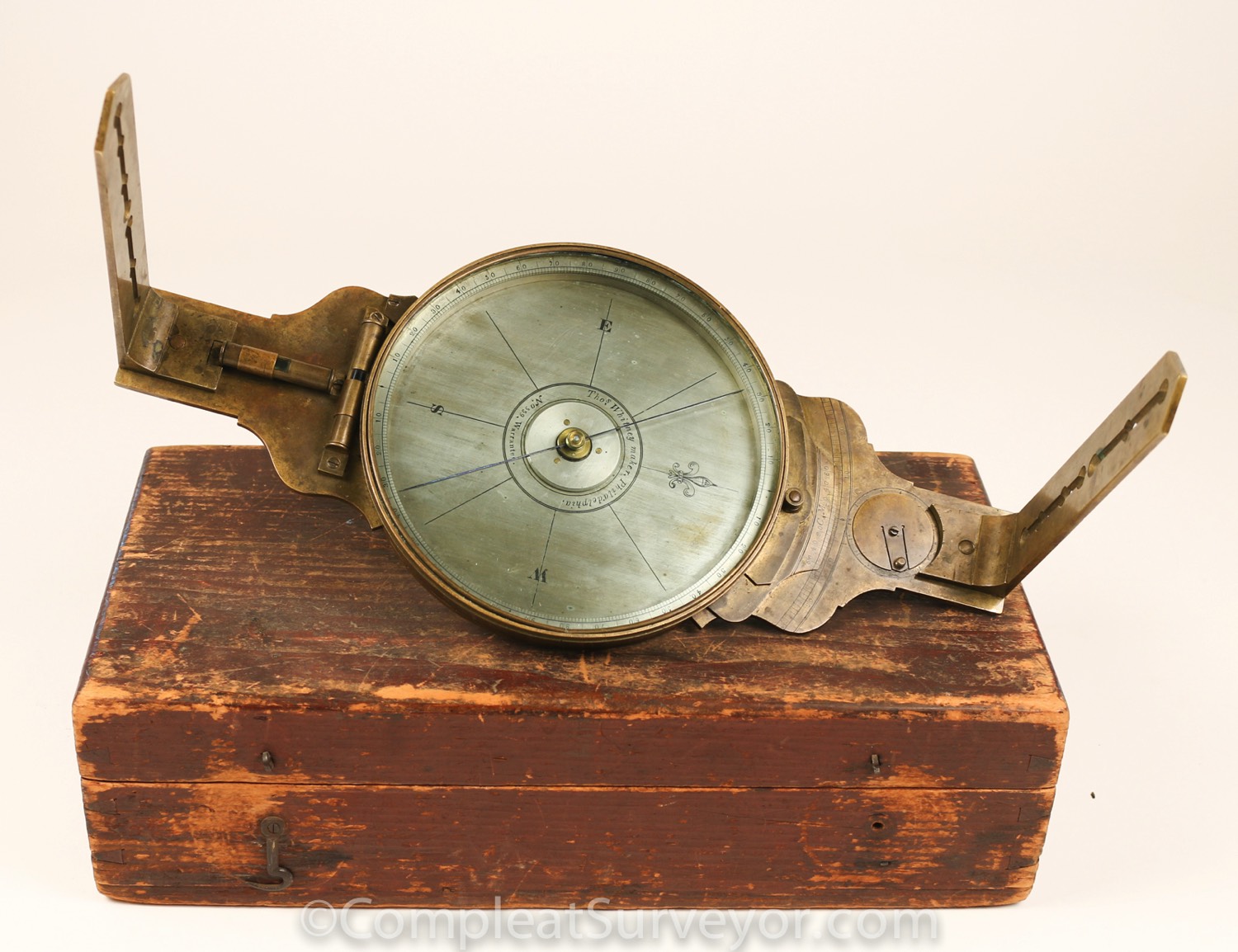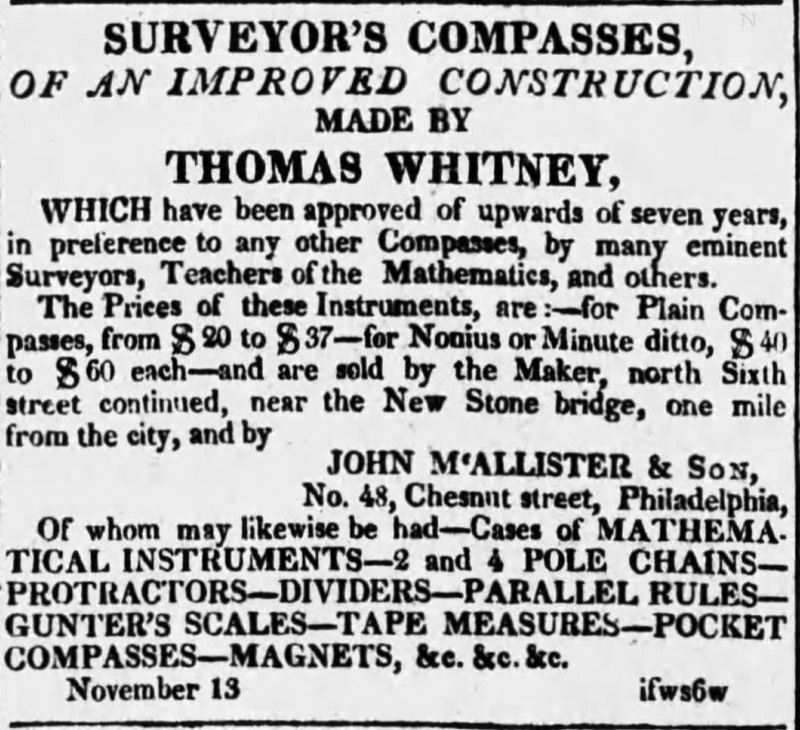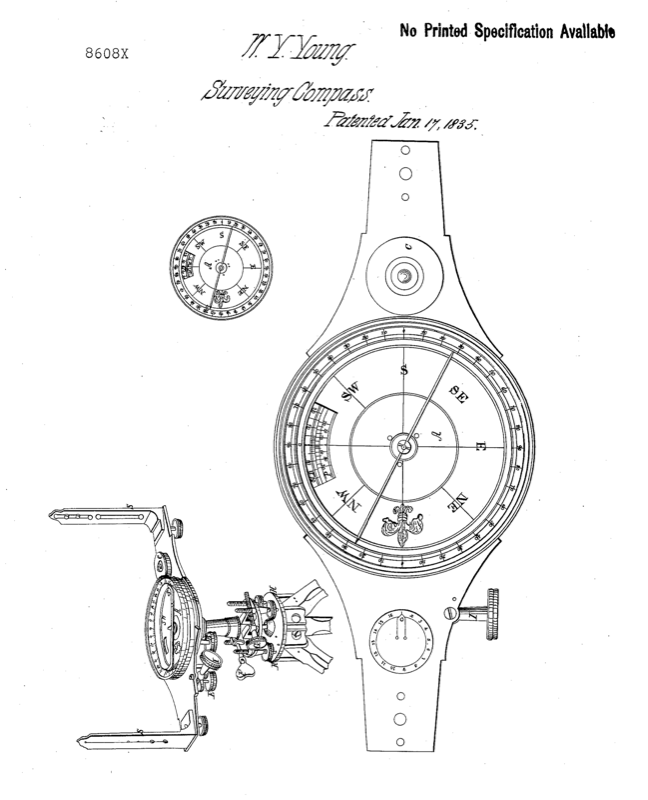
Thomas Whitney Compass - Probably 1823
The Early Railroad Era
Two important things happened after the start of the 19th century that would change instrument making forever in America. First, full-time surveying instrument makers, like Thomas Whitney, popped up and started making affordable compasses in quantity. Second, as the American economy started to evolve, especially with respect to modes of transportation (like canals and railroads), the standard American surveying compass was no longer "good enough" for what surveyors needed. Creative makers, especially William Young, developed new instruments like the Railroad Compass and Transit, to meet the needs of the surveyors working on these large transportation projects. These new instruments signaled the end of the Colonial and Early American Era of Surveying Instruments.
Thomas Whitney - Full Time Maker

Let's focus on Thomas Whitney to start. I view Whitney as a VERY important transitional maker - he was the first maker to focus full-time on surveying instruments, the first maker to produce instruments in significant quantities, and the first maker to advertise meaningfully in newspapers.
After the Revolutionary War ended, skilled clockmakers made brass compasses on a part-time as needed basis. As reflected on The Post-Revolutionary War Era Webpage, the instruments made by the clockmakers were often beautifully engraved works of art. These compasses had to be expensive given the time that went into the engraving. Clockmakers had a near monopoly on making brass compasses too - they could use their clockmaking tools and machines to make surveying compasses. Without the tools and machines, it would extremely hard to divide a circle accurately. Please look at the Compass Accuracy Webpage to see just how accurately these clockmakers could divide a compass ring.
After winning the Revolutionary War, America started to look at opening up and developing the lands west of the settled regions of the country. That created a significant demand for surveyors and new instruments. I suspect the clockmakers produced largely expensive compasses in rather limited quantities when this new demand really started to take hold. I believe that the number of clockmakers was also decreasing at this time as a result of the invention of the patented clock, which significantly reduced the demand for tall handmade clocks. This opened the door for more surveying-focused makers, especially Thomas Whitney, to start producing compasses in quantity.
Interestingly, based on the Compass Accuracy data, it appears that Whitney could divide a compass ring with the same level of accuracy as the best compass makers. Whitney started his business at approximately the same time that Benjamin Rittenhouse went bankrupt and William Potts opted out of making surveying instruments. Thus, there is some chance that Whitney acquired the tools and machines necessary to make VERY accurate divisions on the compass ring from either B Rittenhouse or Potts. Based on the Compass Accuracy Webpage, B Rittenhouse and Potts made the most accurate compasses. If Whitney did not acquire their tools and mechanics, Whitney did one heck of a job creating his own tools and machines. Worth noting - Whitney's estate sale materials suggested that he created his own dividing engine.
Whitney claimed that he had made more than 500 compasses - his last serial number was approximately 560 - and sold those compasses across the country. 500 plus compasses is not a surprising number given how many Whitney compasses have survived. Take a look at the picture of the Whitney Vernier Compass a the top of this Webpage. Whitney standardized the look and feel of his compasses as much as possible, and reduced the amount of time spent on engraving to the BARE minimum. His compasses were high quality and very accurate instruments, but by scaling back on all the flourishes that the clockmakers typically added, especially the engraving, Whitney saved time and lowered his costs significantly. And that would become the American Way, of course.
Whitney had one other important contribution - he trained William Young, who was one of the most important American surveying instrument makers ever. Young combined Whitney's no frills approach with Young's amazing creative instincts, and created a powerhouse instrument making business.
Whitney's full-time - no frills - high quality approach also took hold in the other cities. Troy NY was becoming a major player in instrument making, with the Hanks family and Meneely, and ultimately the Gurley Surveying Instrument Making Empire. While Whitney was the first maker to consistently advertise in newspapers, Meneely would be the first manufacturer to consistently advertise in newspapers across the country.
Plain or Vernier Surveying Compass would look just like Whitney's Compasses 100 years later.
The American Economy Demands New Instruments
Railroads happened as America opened up for westward development. The first railroad opened in 1826 in Massachusetts. The second railroad opened in 1829 was built to replace the 108 mile one Deleware and Hudson Canal. Seventy three railroads were chartered in states east of the Mississippi by mid-1832.
All of these railroads, and the land development that went along with the railroads, required surveying instruments. Lots of surveying instruments. And the surveying instruments needed to me more accurate than a common compass. Guesstimating to the nearest 10 or 15 minutes wasn't good enough for the Railroads.
Take a look at the above 1833 Young advertisement posted immediately above. In the first recommendation, the B&O Railroad claims that it used 7 Young Levels and 8 Young Improved Compasses (the B&O used instruments made by other makers as well). The Young "Improved Compasses" were Young's patented compass (see Pic Below) that could measure angles accurately without reference to the magnetic needle. These instruments would later be referred to as "Theodolite Compasses" in New York City and "Railroad Compasses" by the makers in Troy NY, with the RR Compass name ultimately prevailing. See the Railroad Compass Webpage.
The opening up of the country also required surveying instruments more sophisticated than a plain or vernier surveying compass. Magnetic needles don't fare well when there are local distractions, like iron ore. Local attraction wasn't a significant problem in Colonial and Early America, but local attraction became a HUGE problem once surveyors hit midwest states, like Michigan, where surveyors couldn't survey various areas because of the amount of local attraction. William Burt created the solar compass in 1836 to overcome the problems of using the magnetic compass in areas of local attraction. By 1855 the U.S. General Land Office would mandate the use of the Solar Compass for laying out the main lines for the public land surveys in United States.
While the Plain and Vernier Compasses were "good enough" for most surveys in Colonial and Early America, the compasses weren't "good enough" for what many surveyors needed in 1830 and thereafter as Railroads quickly proliferated and the country opened up for development.
Plain and Vernier Compasses still played a BIG role in America post 1830, but year after year the role played by compasses diminished. If you look at Gurley's Production Records, Plain and Vernier Compass made up only 40% of Gurley's instrument sales in 1857. And that percentage faded a bit year after year.

© 2020 Russ Uzes/Contact Me
